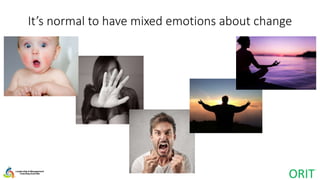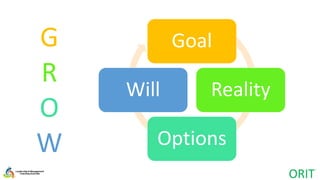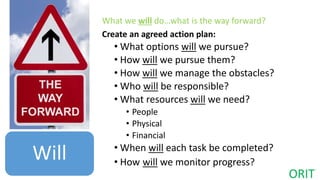This document provides guidance on managing change and resistance to change. It discusses that people resist change due to uncertainty, lack of control, not understanding the need for change, and lack of trust from previous changes. However, people are more accepting of change when they feel in control of it and understand why it's needed. The document emphasizes that effective change requires honesty, transparency, consultation, and visible leadership. It outlines a GROW model for planning change, which involves setting goals, understanding current reality, brainstorming options, and creating an action plan to achieve the desired change. Regular communication and checking in on emotions are also important parts of the change process.








![Keep Chuck
Change Add
?
Share control
Clarke,J.,2010.Tedxperth-JasonClarke-EmbracingChange.[online]Availableat:
<https://www.youtube.com/watch?v=vPhM8lxibSU>.](https://image.slidesharecdn.com/changemanagementworkshopslides-200519013344/85/Change-Management-Workshop-slides-9-320.jpg)
![Reduce uncertainty
Things we
used to be
able to do
and still can
Things we
couldn’t do
before and
still can’t
Things we
used to be
able to do
but can’t
now
Things we
couldn’t do
before but
can now
Business as usual Changing
Clarke, J., 2010. Tedxperth - Jason Clarke - Embracing Change. [online] Available at: <https://www.youtube.com/watch?v=vPhM8lxibSU> .](https://image.slidesharecdn.com/changemanagementworkshopslides-200519013344/85/Change-Management-Workshop-slides-10-320.jpg)










